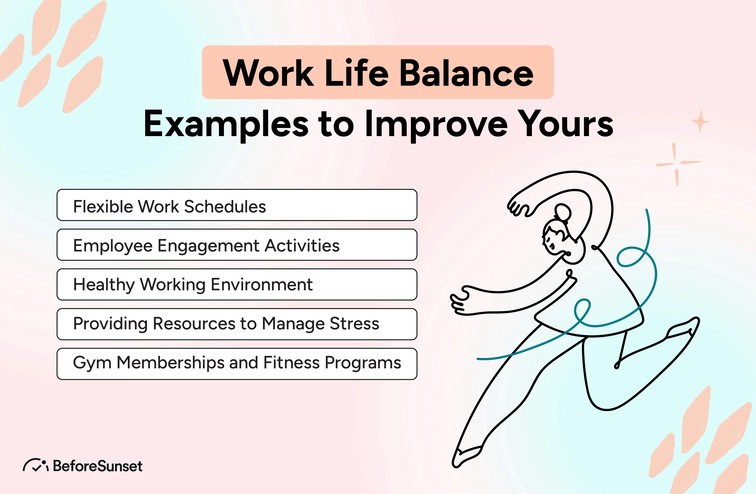To preserve our physical and emotional health while pursuing both professional success and personal fulfillment, work-life balance is a crucial component of modern living. Finding the ideal balance between the responsibilities of our jobs and the pleasures of our personal lives can be difficult, but it is a goal well worth pursuing.
In this blog post, "Work-Life Balance Examples to Improve Yours," we'll look at some concrete, in-the-real-world examples and tactics people can use to improve their work-life balance.
We want to help you live a more contented life where work and personal goals coexist in harmony by exploring these cases and offering insights, inspiration, and practical guidance.

Common Challenges to Achieving Work-Life Balance
Due to a variety of reasons and barriers that people frequently experience in their personal and professional lives, finding a work-life balance can be difficult. To achieve a work-life balance, it might be difficult to:
Demanding Workloads: Scheduling time for leisure and personal pursuits can be challenging when faced with demanding workloads, rushed deadlines, and high job expectations.
Long Workdays: Jobs with long hours, erratic schedules, or a lot of overtime might leave little time for leisure activities and spending time with loved ones.
Lack of Control: Being unable to work remotely or with sufficient autonomy and control over one's working hours might make it more difficult to strike a balance between work and personal life.
Constant Connectivity: Because technology enables constant connectivity for work, it might be difficult to detach from and turn off emails and messages connected to work, even during personal time.
Commuting: Long commutes may take a lot of time and energy, which limits the amount of time available for leisure and personal pursuits.
Job Insecurity: Being overly committed to work and being reluctant to take time off for personal needs and self-care might result from fear of job loss or employment instability.
Pressure to Perform: A workaholic mentality and the drive to succeed professionally can lead people to push themselves too far and disregard their personal lives.
Parenting and Caregiving Responsibilities: Juggling employment with the duties of taking care of young children or elderly relatives can be difficult since it frequently takes a lot of time and effort.
Lack of Support: Striking a balance between work and life may be more difficult if you don't have access to workplace assistance programs like flexible hours, child care, or remote work choices.
Guilt and Expectations: It can be challenging to strike a balance when one is dealing with guilt or expectations from society, especially for women who may feel under pressure to perform well in both their professional and caring duties.
Health Concerns: Health issues, whether mental or physical, can interfere with work-life balance since they need more time and effort for rehabilitation and medical treatment.
Insufficient Self-Care: Skipping out on self-care activities like exercise, a healthy diet, and relaxation can cause burnout and make it more difficult to successfully manage work and personal life.
Saying "No" Easily: It can be difficult to set limits and refuse extra job or social commitments, which can cause overextension and an unbalanced relationship between work and personal life.
Financial Stress: People who are under financial stress may end up working longer hours or taking on more tasks, which leaves them with less time for personal time and leisure.
Lack of Knowledge: Some people may not understand the value of work-life balance or may not be aware of the methods and tools available to assist them in achieving it.
What Are The Three Types of Work-Life Balance?
Three basic categories or methods may be used to classify work-life balance, each of which represents a distinct manner in which people may try to strike a balance between their professional and personal lives. These kinds include
1. Time-Based Work-Life Balance: A work-life balance that is time-based is concerned with setting aside particular times for work and personal obligations. People who place a high priority on time-based balance strive to keep a rigorous separation between work and leisure time.
In order to guarantee that they have set aside time for both work and leisure hobbies, they establish defined limits and follow regular routines. This strategy frequently entails keeping regular working hours, avoiding unnecessary overtime, and making an attempt to "clock out" of the office at the conclusion of the workday.
2. Task-Based Work-Life Balance: Task-based work-life balance places more emphasis on getting things done than on sticking to strict time constraints. People who use this strategy concentrate on completing their professional tasks effectively, regardless of how long it takes.
They might devote the time left over to personal pursuits when responsibilities are finished. This strategy provides flexibility and can be especially helpful for occupations that need creativity or have unpredictable workloads that may not fit into regular working hours.
3. Integration-Based Work-Life Balance: Work-life integration emphasizes the melding of work and personal life while attempting to obfuscate the distinction between the two. This strategy encourages people to effortlessly incorporate work and personal interests into their everyday lives as opposed to rigorously dividing them.
This might entail working from home, having flexible hours, or fitting in personal pursuits throughout the workday. The objective is to reach a state of harmony in which one's personal and professional lives enhance rather than compete for one's time and attention.

Examples of Good Work-Life Balance Initiatives
Many firms are taking proactive steps to develop work-life balance programs as they become more aware of the significant effects it has on employee well-being, productivity, and overall job satisfaction. These programs, procedures, and policies cover a wide range of topics aimed at assisting workers in successfully juggling professional obligations with caring for their personal lives.
Flexible Work Schedules
Flexible work arrangements are a crucial part of successful work-life efforts in contemporary firms. This strategy recognizes that not everyone's demands can be met by the standard 9 to 5 workday and that giving workers more freedom over their working hours may increase their job happiness, productivity, and general well-being.
Flextime is one feature of flexible work schedules that allows employees to change their daily start and end times within specified parameters established by the company. For instance, an employee may decide to start at 7 AM and depart sooner, instead of starting at 9 AM, or to start at 10 AM and remain longer. For those who have long commutes, childcare obligations, or other personal commitments that call for accommodation, this flexibility may be quite useful.
Compressed workweeks, in which workers put in larger hours on fewer days of the week, are another factor. This often entails a four-day workweek with long daily hours. Employees may, for instance, work four 10-hour days followed by a three-day weekend. This strategy can shorten commute times, support work-life balance, and provide more consecutive days off for leisurely pursuits.
Working remotely or from home is an essential component of flexible hours. It eliminates the necessity for daily commuting by enabling workers to work from home or other remote places. In the current digital era, when technology enables smooth communication and cooperation even when team members are not physically present in the workplace, this strategy is especially pertinent. Greater flexibility, a reduction in commuter stress, and better work-life balance may all be benefits of working remotely.
In addition, some businesses provide part-time job opportunities that allow workers to work a lower number of hours per week or on a different schedule than full-time jobs. For people who need more time for personal responsibilities, such as caring for family members or pursuing school, part-time work might be a great option.
Flexible work arrangements are advantageous for both businesses and employees. They may raise employee morale, increase company productivity overall, and aid in recruiting and keeping top personnel. However, to guarantee that work commitments are completed while taking into account individual demands, efficient adoption and administration of flexible work schedules necessitate clear regulations, communication, and trust between employers and employees.
Employee Engagement Activities
Activities that promote employee engagement are crucial to creating a healthy work-life balance within a firm. These programs aim to improve workers' happiness, motivation, and job satisfaction, which will foster a more peaceful and effective work environment.
The encouragement of both physical and mental health is an important component of employee engagement initiatives. Offering wellness initiatives that promote regular exercise, stress reduction, and wholesome eating practices is one way to do this. Employers may support employees in prioritizing their health by setting up yoga sessions, offering gym memberships, or providing mental health services. This lessens the harmful effects of work-related stress and encourages a healthy work-life balance.
Another successful engagement method is to provide flexible work schedules. Offering choices like telecommuting or giving employees the freedom to set their own work hours can help them manage their personal life more effectively while still carrying out their job duties. This adaptability recognizes that workers have a variety of requirements and responsibilities outside of the workplace, such as obligations to their families, their education, or their own personal growth.
Beyond-legal-requirements paid time off (PTO) programs can make a significant difference in work-life balance. Employees are allowed to take the time they require to rest, rejuvenate, and spend meaningful time with loved ones thanks to generous vacation days, holidays, and paid parental leave. These regulations demonstrate the company's commitment to its workers' welfare outside of the job.
By encouraging a sense of belonging and camaraderie, organizations may also engage their workforce. Regular team-building exercises, social gatherings, and chances for cooperation foster an accepting and diverse workplace culture. Employees are more likely to perceive work as a good aspect of their life when they feel connected to and like spending time with their coworkers.
By offering possibilities for professional advancement and skill development, mentoring and professional development programs may help improve work-life balance. Employees are more likely to stay engaged and motivated when they can see a clear route for growth and get mentoring since they know their efforts will be rewarded.
Furthermore, it is crucial to foster a culture of task management and reasonable expectations. Burnout may be avoided by encouraging employees to be honest about their workload and setting attainable goals. Employees are better able to successfully manage their professional and personal life when they believe their efforts are recognized and their workloads are appropriate.

Healthy Working Environment
Fostering a positive work-life balance for people inside a business starts with a healthy workplace. It includes different elements of the workplace that support workers' physical, mental, and emotional health and enable them to successfully juggle their job and personal commitments.
A healthy workplace promotes physical well-being first and foremost. To prevent injuries, this entails setting up ergonomic workstations and maintaining a safe workplace. Employees who feel safe and secure in their work environment are more likely to concentrate on their jobs without undue stress or pain. Furthermore, providing healthier food alternatives in cafeterias or break areas may promote better nutrition, boosting staff members' physical health even more.
A crucial component is one's mental health. The value of mental health support is acknowledged in a healthy workplace. It offers tools for stress management, and access to counseling services, and promotes open discussion of mental health concerns. Employees can better manage stress, anxiety, and other mental health issues as a result of work- or personal-related causes.
A healthy workplace also encourages work-life balance by being flexible. It recognizes that workers have a variety of demands and responsibilities outside of the workplace, such as obligations to their families, hobbies, and further education. Employers may do this by allowing telecommuting, allowing flexible work hours, and having liberal paid time off policies. Employees may better manage their time and responsibilities thanks to these measures, which lessens the strain of juggling work and personal obligations.
The creation of a positive work environment depends on effective communication and supportive management. Work-life balance may be greatly aided by managers who are kind, personable, and sensitive to staff requirements. A supportive management style includes regular check-ins, performance reviews, and opportunities for workers to express their problems or recommendations.
Collaboration and teamwork are also valued in a positive workplace environment. A healthy workplace culture is fostered by team-building exercises, clear lines of communication, and friendliness among coworkers. Employees are more likely to enjoy their work and have a good work-life balance when they feel linked to and supported by their colleagues.
Last but not least, businesses that support professional advancement foster a positive work atmosphere. Employees are more likely to stay engaged and motivated in their jobs when they perceive a clear route for progress, get training and development opportunities, and have access to mentors. Work-life balance is further supported by employees' sense of contentment as a result of knowing that their efforts are appreciated and rewarded.
Gym Memberships and Fitness Programs
Fitness classes and gym memberships are important elements of a successful work-life balance effort inside firms. These benefits encourage employees' physical and mental health as well as their general quality of life by giving them easy access to fitness centers and other wellness-related activities.
The enhancement of physical health is a key benefit of fitness memberships and programs. Maintaining excellent health, lowering the risk of chronic diseases, and controlling stress all depend on regular exercise. Employers help workers prioritize their physical well-being by offering gym memberships or on-site workout facilities. Even though their work schedules are hectic, having access to fitness equipment, courses, and personal trainers enables employees to include regular exercise in their daily routines.
Additionally, these programs are essential for stress reduction. Endorphins, which naturally elevate mood, are known to be released during exercise. Physical activity can help workers manage stress, elevate their mood, and increase their overall resilience. Physical activity can also be done before or after work or during work breaks. This in turn lessens the detrimental effects of professional stresses on individuals' personal lives, promoting a healthy work-life balance.
Memberships to gyms and fitness courses can offer chances for networking and team development. Employees are encouraged to interact with coworkers in a casual, non-work context through team competitions or group exercise courses. These encounters promote a sense of camaraderie and can solidify ties among coworkers, fostering a pleasant work atmosphere.
Fitness programs also demonstrate a company's dedication to the well-being of its staff. Employers clearly demonstrate their value for their workers' holistic requirements beyond simply their professional accomplishments when they make investments in the physical well-being of their workforce. Employee morale, work satisfaction, and loyalty may increase as a result.
These programs also help employees maintain a healthy work-life balance. Organizations facilitate workers' integration of exercise into everyday routines by providing fitness alternatives at the office or financing club subscriptions. This ultimately results in a more balanced and satisfying existence by freeing up time outside of work for personal and family interests.

Offering Paid Time Off for Vacation or Sick Days
A strong work-life balance strategy inside firms must offer paid time off (PTO) for holidays or sick days. These policies encourage employees' efforts to strike a good balance between their personal and professional lives while also recognizing the significance of employee well-being.
Rest and refreshment are two major advantages of vacation PTO. Regular time away from the office, such as holidays, enables workers to rejuvenate on a physical and mental level. It provides an opportunity to unplug from work-related pressures and a change of environment, both of which can greatly enhance general well-being. Employees are more productive and satisfied with their jobs when they return to work feeling renewed and energized.
As they take care of employees' personal and medical requirements, sick days are crucial for maintaining a healthy work-life balance. Having access to paid sick days guarantees that workers may prioritize their health without the burden of missing wages when they are ill or need to attend medical appointments. This not only improves their physical health but also lessens the possibility of transmitting disease at work.
Furthermore, these regulations support worker happiness and morale. Employees feel cherished and supported by their company when they are aware that they have the freedom to take time off when necessary, whether for a vacation or an illness. Increased loyalty and devotion to the company may result from this feeling of trust and gratitude, which also promotes a healthy work environment.
PTO for vacation and sick days is another retention and recruiting tactic. When weighing employment offers, prospective workers frequently take these advantages into account. PTO rules that are generous and accommodating are more likely to draw in top candidates and keep seasoned employees. Consequently, a more reliable and knowledgeable workforce results.
Additionally, these regulations boost worker productivity. Employees are more likely to perform at their peak at work when they are well-rested and have the chance to address health problems quickly. As a result, productivity may rise and chronic illness or burnout-related absences may decline.
Streamlining Processes and Automating Tasks
Process simplification and task automation are crucial components of encouraging a healthy work-life balance for people in firms. These techniques not only increase productivity but also lessen stress at work and free up vital time for activities with friends and family.
In order to increase productivity and decrease turnaround time, procedures must be optimized. Organizations may assist employees in completing their activities more quickly and with less effort by removing pointless processes, decreasing bottlenecks, and streamlining workflows. This not only increases output but also lessens the need for overtime and long workdays, allowing staff members to leave the office on schedule and manage their personal lives more effectively.
By employing technology to carry out monotonous or time-consuming activities without human involvement, task automation advances streamlining. Routine data input, email answers, report production, and other administrative tasks can be handled by automation tools and software. Automating these duties allows staff to concentrate on more strategic and important areas of their work, improving work-life balance and job satisfaction.
Additionally, automation lowers the danger of burnout by preventing staff from being overburdened with a never-ending stream of boring duties. Employees' mental and emotional energy is better spent on their personal lives when they aren't consumed with administrative tasks, which lowers stress at work and enhances general well-being.
Another key advantage of simplifying procedures and automating jobs is increased workplace flexibility. Employees are better able to benefit from flexible work arrangements, including telecommuting or flexible hours, when they have more effective workflows and are not continuously under pressure to achieve strict deadlines. Employees are better able to manage their professional obligations with other commitments, such as family obligations or personal activities, thanks to this flexibility.
Additionally, automation and simplification help with time management. When workers are not weighed down by tedious physical activities, they may arrange their time more wisely. They can schedule their day more effectively, set priorities, and leave work on time, certain that they have completed everything that is required.

Providing Resources to Manage Stress and Mental Health Issues
A successful work-life balance strategy inside firms must include services to handle stress and mental health concerns. It acknowledges the value of worker wellbeing and provides the assistance required to address the psychological and emotional components of work-life balance.
The availability of services for mental health is a crucial component of this program. Through an Employee Assistance Program (EAP) or health insurance coverage, employers can give staff members access to mental health specialists like counselors or therapists. These tools provide a private and encouraging setting for workers to discuss concerns at work, personal difficulties, and mental health issues, eventually assisting them in better managing their well-being.
Organizations might also provide stress management workshops and programs. These programs provide participants with the skills and resources they need to manage stress at work and develop resilience. Training in stress management may involve mindfulness meditation, breathing exercises, time management skills, and seminars on work-life balance. These tools provide workers the capacity to handle challenges in a proactive manner and keep a better balance between work and life.
Having flexible work schedules might help you manage your stress and maintain good mental health. Allowing workers to change their work schedules or telecommute when necessary may ease the strains of commuting, meet personal obligations, and improve the working environment. Employees who have control over their work schedules can better manage their stress levels and keep a better balance between their personal and professional lives.
Organizations can also encourage a climate of open discussion about mental health. A more supportive work environment can be achieved by encouraging staff members to speak with managers or HR specialists about their difficulties and pressures without worrying about stigma or unfavorable repercussions. This can result in early intervention and aid for those who might be dealing with mental health concerns, ensuring they get the support they require.
Programs for workplace wellness can also help with stress management and mental health assistance. These courses might cover themes like mindfulness training, yoga, fitness, and lectures on mental health and wellbeing. When wellness services are easily accessible to workers, they are more likely to exercise self-care, which can improve their mental and emotional well-being.
Benefits of Improving Work-Life Balance
Enhancing work-life balance has several advantages for people, businesses, and society at large. These advantages consist of:
Enhanced Well-Being: People who have a better work-life balance report feeling happier overall. They report less stress, less burnout, and improved physical and mental health. Greater life satisfaction and pleasure result from this.
Increased Productivity: Productivity is likely to increase for those who successfully balance their home and professional life. Distractions, absenteeism, and presenteeism (being present at work but not completely engaged) are less likely to affect them.
Greater Job Satisfaction: Employees who successfully balance their work and personal obligations report higher levels of job satisfaction. Increased job loyalty, improved morale, and lower turnover rates can result from this.
Improved Mental Health: A better work-life balance can help with mental health, which can be improved. It lessens the possibility of developing stress-related mental health conditions including anxiety and depression. Employees are more likely to report feeling emotionally secure and mentally tough.
Enhanced Physical Health: Maintaining a balance between work and personal life enables people to give priority to self-care, exercise, and diet. Better physical health, a lower likelihood of developing chronic illnesses, and a longer life span can result from this.
Better Relationships: People who maintain a healthy work-life balance have more time and energy to devote to their interpersonal connections, especially those with friends and family. Better social ties help people feel supported emotionally and are happier as a whole.
Increased Creativity and Innovation: Leading a balanced lifestyle enables people to pursue a variety of interests and experiences outside of the workplace. This may inspire originality and innovation, fostering both individual development and positive contributions to the workplace.
Greater Retention and Recruitment: Businesses that value work-life balance are more likely to draw and keep great personnel. Employee retention is higher at companies that appreciate their employees' well-being and provide flexibility.
Cost Savings: Organizations may see cost savings by enhancing work-life balance. Reduced turnover rates translate into lower expenses for hiring, training, and onboarding new staff. Additionally, less money could be spent on healthcare for workers who are healthier.
Increased Employee Engagement: Dedicated workers are more dedicated to their tasks and the objectives of the company. A healthy work-life balance encourages greater employee engagement, which enhances job performance and increases customer happiness.
Benefits for Society: When a sizable segment of the workforce has a better work-life balance, there may be wider social advantages. These include decreased rates of family dissolution, fewer healthcare expenses, and a more active and healthier populace.
Sustainability: Promoting a healthy lifestyle can result in more environmentally friendly working conditions. Long-term professional growth is supported, and the possibility of employee burnout, which may be expensive for employers, is decreased.
No Matter What Your Job Is BeforeSunset is Here To Create That Work-Life Balance
BeforeSunset AI plays a pivotal role in achieving work-life balance by helping individuals streamline their work processes, prioritize tasks, and manage their time more efficiently. Try BeforeSunset AI today!

